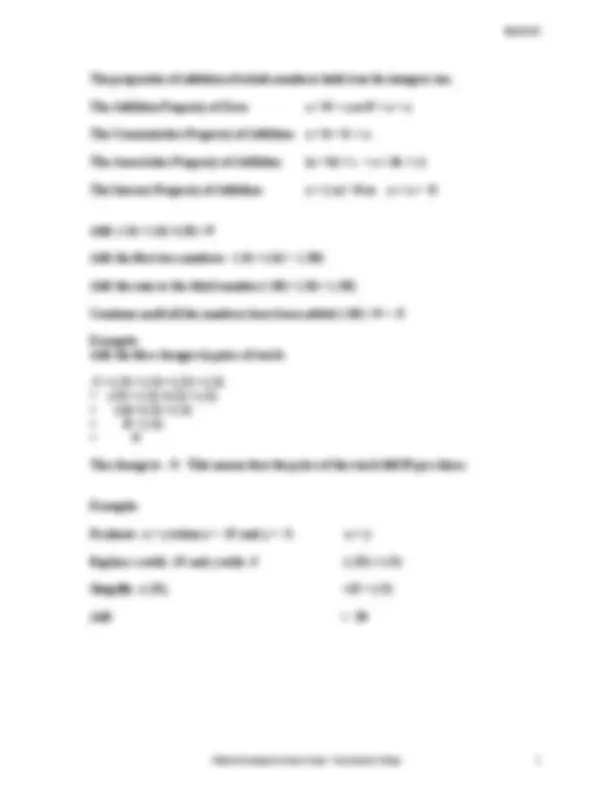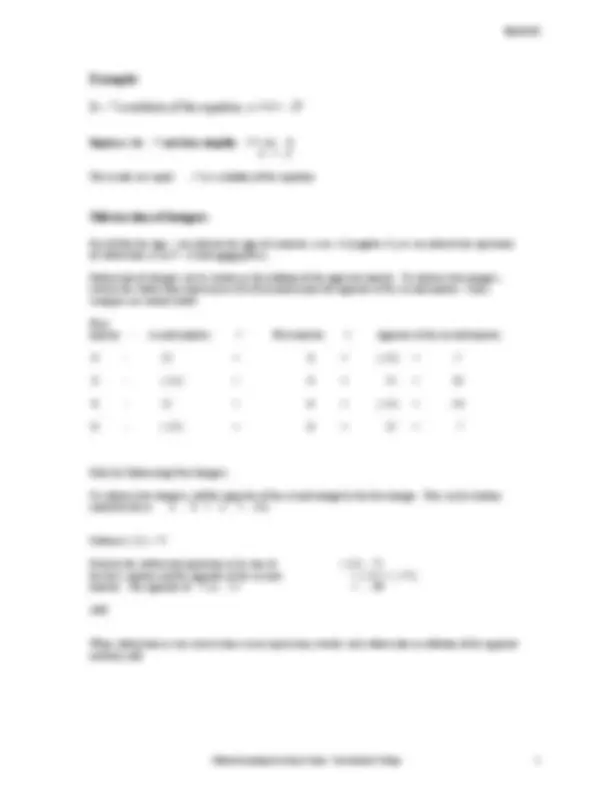





Study with the several resources on Docsity

Earn points by helping other students or get them with a premium plan


Prepare for your exams
Study with the several resources on Docsity

Earn points to download
Earn points by helping other students or get them with a premium plan
Community
Ask the community for help and clear up your study doubts
Discover the best universities in your country according to Docsity users
Free resources
Download our free guides on studying techniques, anxiety management strategies, and thesis advice from Docsity tutors
How to add and subtract integers using a number line and the properties of addition. It provides examples of adding and subtracting integers with the same and different signs, and discusses the inverse property of addition. The document also covers the subtraction of integers by rewriting it as addition of the opposite number.
What you will learn
Typology: Schemes and Mind Maps
1 / 5

This page cannot be seen from the preview
Don't miss anything!




An integer can be represented or graphed on a number line by an arrow. An arrow pointing to the rightrepresents a positive num ber. An arro w pointing to the left represen ts a negative num ber. The absolute value of the number can be determined by counting the distance to zero, or by counting the distancebetween n umbers in the arrow. Th e integers 5 an d –4 are shown on th e number line in the figure be low.
Another example of integers or positive and negative numbers is used with a checking account or dealingwith money. A deposit to your checking account or pocket is an example of an addition called a positive integer (number or amount); a deduction or expense is an example of a negative integer (number/amount). If there is a balance of $25 in a checking account, and a check is written for $30, the account will beoverdrawn/overspent by $5.
The sum of two integers can be shown on a number line. To add two integers, find the point on the number line corresponding to the first addend (integer). The sum is the number directly below thetip of the arrow.
Example: +
4 + 2 = 6 -7 -6 -5 -4 -3 -2 1 - 0 1 2 3 4 5 6 7
-4 +(-2) = - 6 -7 -6 -5 -4 -3 -2 1 - 0 1 2 3 4 5 6 7
-4 + 2 = - -7 -6 -5 -4 -3 -2 1 - 0 1 2 3 4 5 6 7
-7 -6 -5 -4 -3 -2 1 - 0 1 2 3 4 5 6 7
The signs of the addends can categorize the sums shown above. The addends have the same sign. 4 + 2 = 6 positive 4 plus positive 2 equals 6 -4 + (-2) = -6 negative 4 plus negative 2 equals – The adde nds have differ ent signs. -4 + 2 = -2 negative 4 plus positive 2 equals negative 2 4 + (-2) = -6 positive 4 plus negative 2 equals positive 2
Rule for A dding Tw o Integers: TO ADD INTEGERS W ITH THE SA ME SIGN , add the absolute values of the numbers.attach the sign of the adden ds. Then
TO A DD IN TEGE RS W ITH D IFFER ENT S IGNS , find the ab solute va lues of the numbe rs.Subtract the smaller absolute value from the larger absolute value. Then attach the sign of the addend with the largest value.
Examples:
Replace x by - 7 and then simplify. –7 + 4 = -3 = -3-
The results are equal. –7 is a solution of the equation.
Recall that the sign – can indicate the sign of a number, as in –3 (negative 3), or can indicate the operationof subtraction, as in 9 – 3 (nine minus three).
Subtraction of integers can be written as the addition of the oppo site number. To sub tract two integers,rewrite the subtraction expression as the first number plus the opposite of the second number. Some examples are shown below. Firstnumber - second number = First number + opposite of the second number
8 - 15 = 8 + (-15) = - 8 - (-15) = 8 + 15 = 23 -8 - 15 = -8 + (-15) = - -8 - (-15) = -8 + 15 = 7
Rule for Subtracting Two Integers To subtract two integers, add the opposite of the second integer to the first integer. This can be writtensymbolically as a - b = a + (-b).
Subtract (-15) – 75 Rewrite the subtraction operation as he sum of (-15) - 75 the first number and the opposite of the secondnumber. The opposite of 75 is - 75. = (-15) + (-75)= - 90
Add.
When subtraction o ccurs severa l times in an exp ression, rewrite each subtra ction as add ition of the op posite and then add.
Subtract : -13 - 5 - (-8) -13 - 5 - (-8) Rewrite each subtraction as addition of theOpposite. = -13 + (-5) + 8
Add. ==^ -18 + 8- 10